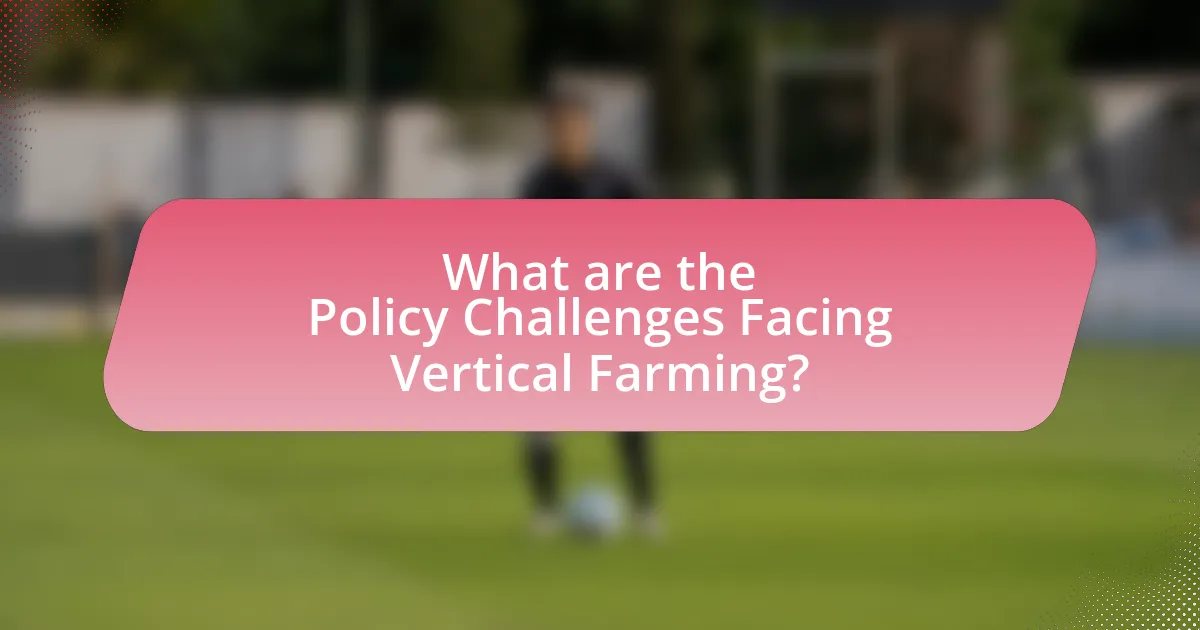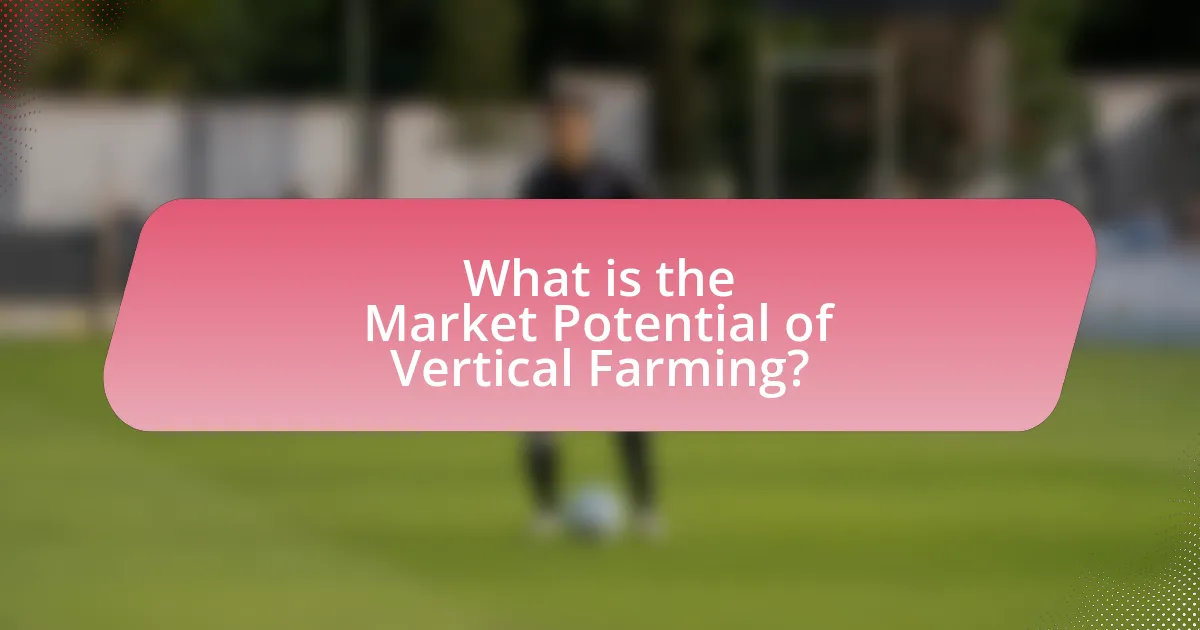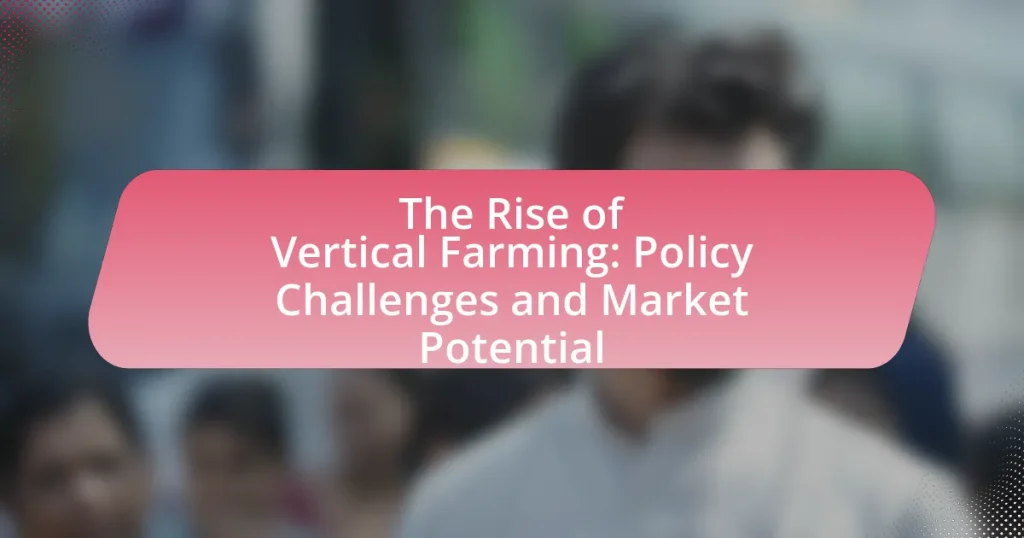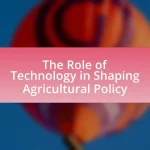Vertical farming is an innovative agricultural practice that involves growing crops in vertically stacked layers, utilizing controlled-environment agriculture technology to maximize space and resource efficiency. This method significantly reduces land use and water consumption compared to traditional farming, making it a sustainable solution for food production in urban areas. The article explores the differences between vertical farming and conventional agriculture, the technologies employed, and the environmental benefits it offers. It also addresses the policy challenges and regulatory hurdles that vertical farms face, as well as the market potential and current trends driving growth in this sector. Additionally, it highlights the role of consumer demand and investment in shaping the future of vertical farming.

What is Vertical Farming?
Vertical farming is an innovative agricultural practice that involves growing crops in vertically stacked layers or structures, often utilizing controlled-environment agriculture technology. This method maximizes space efficiency and resource use, allowing for year-round production regardless of external weather conditions. According to a report by the Food and Agriculture Organization, vertical farming can significantly reduce land use and water consumption compared to traditional farming methods, making it a sustainable solution to food production challenges in urban areas.
How does Vertical Farming differ from traditional agriculture?
Vertical farming differs from traditional agriculture primarily in its use of vertical space and controlled environments to grow crops. While traditional agriculture relies on horizontal land and natural conditions, vertical farming utilizes stacked layers and often incorporates hydroponics or aeroponics, allowing for year-round production regardless of climate. This method can significantly reduce land use by up to 90% and water consumption by up to 95% compared to conventional farming practices, as evidenced by studies showing that vertical farms can produce more food per square foot than traditional farms.
What technologies are utilized in Vertical Farming?
Vertical farming utilizes technologies such as hydroponics, aeroponics, and aquaponics to grow crops in controlled environments. Hydroponics involves growing plants in nutrient-rich water without soil, while aeroponics uses mist to deliver nutrients directly to plant roots. Aquaponics combines hydroponics with aquaculture, allowing fish and plants to grow symbiotically. Additionally, vertical farms often employ LED lighting systems to optimize plant growth, climate control systems to maintain ideal temperature and humidity, and automation technologies for monitoring and managing crop health. These technologies enhance resource efficiency and increase crop yields, making vertical farming a sustainable agricultural practice.
What are the key components of a Vertical Farm?
The key components of a vertical farm include growing systems, lighting, climate control, and nutrient delivery systems. Growing systems, such as hydroponics or aeroponics, allow plants to grow without soil, maximizing space and efficiency. Lighting, often provided by LED technology, ensures plants receive adequate light for photosynthesis, regardless of external conditions. Climate control systems regulate temperature, humidity, and air circulation, creating optimal growing environments. Nutrient delivery systems supply essential minerals and nutrients directly to the plants, enhancing growth rates and yields. These components work together to create a sustainable and efficient farming method that can be implemented in urban settings, addressing food security and reducing transportation emissions.
Why is Vertical Farming gaining popularity?
Vertical farming is gaining popularity due to its ability to produce food in urban areas while minimizing land use and resource consumption. This innovative agricultural method utilizes controlled environments to grow crops vertically, which significantly increases yield per square foot compared to traditional farming. According to a report by the Food and Agriculture Organization, urban agriculture, including vertical farming, can help address food security challenges in densely populated areas, where land is scarce. Additionally, vertical farms often employ hydroponics or aeroponics, which use up to 90% less water than conventional farming methods, making them more sustainable. The increasing demand for fresh, locally sourced produce further drives the growth of vertical farming, as consumers seek alternatives to food transported over long distances.
What environmental benefits does Vertical Farming provide?
Vertical farming provides significant environmental benefits, including reduced land use, lower water consumption, and decreased carbon emissions. By utilizing stacked layers of crops in controlled environments, vertical farms can produce food in urban areas, minimizing the need for extensive agricultural land. Research indicates that vertical farming can use up to 90% less water than traditional farming methods due to recirculating systems that optimize water usage. Additionally, vertical farms can lower carbon emissions by reducing transportation distances, as they are often located closer to consumers. Studies show that this localized production can cut food miles significantly, contributing to a smaller carbon footprint.
How does Vertical Farming address food security issues?
Vertical farming addresses food security issues by enabling the production of crops in urban environments, thereby reducing dependency on traditional agriculture. This method utilizes controlled environments to grow food year-round, which mitigates the impact of climate change and extreme weather on crop yields. For instance, vertical farms can produce up to 10 times more food per square foot compared to conventional farming, as demonstrated by a study from the University of Controlled Environment Agriculture, which highlights the efficiency of space utilization in urban settings. Additionally, vertical farming reduces transportation costs and emissions, as food can be grown closer to consumers, further enhancing food availability and accessibility.

What are the Policy Challenges Facing Vertical Farming?
Policy challenges facing vertical farming include regulatory hurdles, zoning laws, and access to funding. Regulatory hurdles often arise from outdated agricultural policies that do not account for innovative farming methods, leading to difficulties in obtaining necessary permits. Zoning laws can restrict the locations where vertical farms can operate, limiting their potential to be integrated into urban environments. Additionally, access to funding is a significant challenge, as investors may be hesitant to finance projects that lack a proven track record or clear regulatory frameworks. These challenges hinder the growth and scalability of vertical farming initiatives, impacting their overall market potential.
What regulatory hurdles do Vertical Farms encounter?
Vertical farms encounter several regulatory hurdles, primarily related to zoning laws, building codes, and food safety regulations. Zoning laws often restrict agricultural activities in urban areas, complicating the establishment of vertical farms. Building codes may impose limitations on structural requirements and energy use, impacting the design and operational efficiency of these facilities. Additionally, food safety regulations, such as those enforced by the FDA, require compliance with strict standards for the production and handling of food, which can be challenging for innovative farming methods. These regulatory challenges can hinder the growth and scalability of vertical farming operations.
How do zoning laws impact the establishment of Vertical Farms?
Zoning laws significantly impact the establishment of vertical farms by dictating where these facilities can be located and what activities they can engage in. These regulations can either facilitate or hinder the development of vertical farms based on factors such as land use designations, building codes, and agricultural policies. For instance, in urban areas where zoning laws favor commercial or industrial use, vertical farms may find it easier to secure permits and operate, while in residential zones, restrictions may limit their establishment due to concerns about noise, traffic, or aesthetics. Additionally, some cities have begun to adapt their zoning laws to promote urban agriculture, recognizing the benefits of vertical farming for food security and sustainability. This shift can lead to increased opportunities for vertical farms to thrive in metropolitan settings.
What safety and health regulations must Vertical Farms comply with?
Vertical farms must comply with safety and health regulations that include the Food Safety Modernization Act (FSMA), local health department regulations, and Occupational Safety and Health Administration (OSHA) standards. The FSMA mandates preventive controls for food safety, requiring vertical farms to implement measures to minimize contamination risks. Local health regulations often dictate sanitation practices, pest control, and water quality standards specific to agricultural operations. OSHA standards ensure safe working conditions for employees, addressing issues such as equipment safety, chemical handling, and ergonomic practices. Compliance with these regulations is essential for ensuring food safety, worker health, and operational legality in the vertical farming industry.
How do government policies influence the growth of Vertical Farming?
Government policies significantly influence the growth of vertical farming by providing financial incentives, regulatory frameworks, and research support. For instance, subsidies for sustainable agriculture and tax breaks for urban farming initiatives encourage investment in vertical farming technologies. Additionally, zoning laws and building codes that facilitate the establishment of vertical farms in urban areas can enhance accessibility and operational feasibility. Research funding from government agencies, such as the USDA’s support for innovative agricultural practices, further promotes advancements in vertical farming techniques. These policies collectively create a conducive environment for the expansion and sustainability of vertical farming operations.
What incentives are available for Vertical Farming initiatives?
Incentives available for vertical farming initiatives include government grants, tax credits, and subsidies aimed at promoting sustainable agriculture. For instance, the USDA offers various funding programs that support innovative farming practices, including vertical farming, to enhance food security and environmental sustainability. Additionally, some local governments provide tax incentives to encourage investment in urban agriculture projects, which can significantly reduce operational costs for vertical farms. These financial incentives are designed to stimulate growth in the sector, making it more viable and attractive for entrepreneurs and investors.
How can policy frameworks support sustainable practices in Vertical Farming?
Policy frameworks can support sustainable practices in vertical farming by establishing regulations that promote resource efficiency and environmental protection. These frameworks can incentivize the use of renewable energy sources, such as solar or wind, which are crucial for reducing the carbon footprint of vertical farms. For instance, the European Union’s Common Agricultural Policy includes measures that encourage sustainable agricultural practices, which can be adapted to support vertical farming initiatives. Additionally, policies can facilitate access to funding and grants for research and development in vertical farming technologies, thereby fostering innovation that enhances sustainability. Evidence from the United Nations Food and Agriculture Organization indicates that well-structured policies can lead to a 30% increase in resource efficiency in agricultural practices, including vertical farming.

What is the Market Potential of Vertical Farming?
The market potential of vertical farming is significant, projected to reach approximately $12.77 billion by 2026, growing at a compound annual growth rate (CAGR) of 24.8% from 2021. This growth is driven by increasing urbanization, the demand for fresh produce, and the need for sustainable agricultural practices. According to a report by MarketsandMarkets, vertical farming offers advantages such as reduced land use, lower water consumption, and the ability to grow crops year-round, which enhances food security in urban areas.
What are the current market trends in Vertical Farming?
Current market trends in vertical farming indicate significant growth driven by technological advancements, increased consumer demand for local produce, and sustainability concerns. The global vertical farming market was valued at approximately $3.1 billion in 2020 and is projected to reach around $12.77 billion by 2026, growing at a CAGR of 25.5% during the forecast period. This growth is fueled by innovations in hydroponics, aeroponics, and controlled environment agriculture, which enhance crop yields and reduce resource consumption. Additionally, urbanization and the need for food security in densely populated areas are pushing the adoption of vertical farming solutions.
How is consumer demand shaping the Vertical Farming industry?
Consumer demand is significantly shaping the Vertical Farming industry by driving innovation and increasing investment in sustainable agricultural practices. As consumers increasingly prioritize fresh, locally sourced, and pesticide-free produce, vertical farming systems are being developed to meet these preferences, resulting in a projected market growth rate of 24.8% from 2021 to 2028, according to a report by Grand View Research. This demand for sustainable food options is prompting vertical farms to adopt advanced technologies such as hydroponics and aeroponics, which optimize resource use and reduce environmental impact, thereby aligning with consumer values for sustainability and health.
What role do investors play in the growth of Vertical Farming?
Investors play a crucial role in the growth of vertical farming by providing the necessary capital for technology development, infrastructure, and operational scaling. Their financial support enables startups and established companies to innovate in areas such as hydroponics, automation, and energy efficiency, which are essential for enhancing productivity and reducing costs. For instance, in 2021, global investment in vertical farming reached approximately $1.5 billion, highlighting the increasing confidence investors have in this sector’s potential to address food security and sustainability challenges. This influx of capital not only accelerates research and development but also facilitates market entry and expansion, ultimately driving the industry’s growth.
What challenges do businesses face in the Vertical Farming market?
Businesses in the Vertical Farming market face significant challenges, including high initial capital investment, technological complexity, and regulatory hurdles. The high costs associated with setting up vertical farms, which can range from hundreds of thousands to millions of dollars, often deter potential entrants. Additionally, the reliance on advanced technologies such as hydroponics, aeroponics, and climate control systems adds layers of complexity that require specialized knowledge and skills. Regulatory challenges also arise from varying local policies regarding land use, water rights, and food safety standards, which can complicate operations and market entry. These factors collectively hinder the growth and scalability of vertical farming businesses.
How do operational costs affect the viability of Vertical Farms?
Operational costs significantly impact the viability of vertical farms by determining their profitability and sustainability. High operational costs, including energy, labor, and maintenance, can lead to financial losses, making it difficult for vertical farms to compete with traditional agriculture. For instance, energy consumption for lighting and climate control can account for up to 30% of total operational costs, as reported in a study by the University of California, Davis. This financial burden necessitates efficient resource management and innovative technologies to reduce costs, such as LED lighting and automated systems. Therefore, managing operational costs is crucial for the long-term success and scalability of vertical farming initiatives.
What competition exists within the Vertical Farming sector?
The competition within the Vertical Farming sector includes various companies and technologies that aim to optimize space, resources, and crop yield. Key players such as AeroFarms, Plenty, and Bowery Farming utilize advanced hydroponic and aeroponic systems to grow produce efficiently, often competing on factors like technology, scalability, and sustainability. According to a report by ResearchAndMarkets, the global vertical farming market is projected to reach $12.77 billion by 2026, indicating significant investment and competition among startups and established agricultural firms. This competitive landscape is further intensified by the entry of traditional agricultural companies adapting to urban farming trends, highlighting the dynamic nature of the sector.
What are the best practices for succeeding in Vertical Farming?
The best practices for succeeding in vertical farming include optimizing space utilization, implementing efficient resource management, and utilizing advanced technology. Optimizing space involves using vertical structures and hydroponic or aeroponic systems to maximize crop yield per square foot. Efficient resource management focuses on minimizing water and nutrient usage while maximizing plant growth, which can be achieved through precision agriculture techniques. Advanced technology, such as LED lighting and climate control systems, enhances growth conditions and reduces energy consumption. According to a study by the University of Controlled Environment Agriculture, vertical farms can produce up to 10 times more food per acre compared to traditional farming methods, demonstrating the effectiveness of these best practices.















